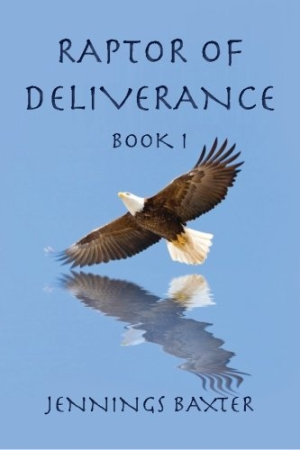Raptor of Deliverance - Book I
A mysterious tone carries this paranormal thriller into a world of symbolism.
Psychic phenomena and paranormal intrigue create a unique pathway into the realm of science fiction in Raptor of Deliverance, a mesmerizing thriller. Jennings Baxter explores the frightening prospect of fantastical, mind-controlled weaponry—not a topic for the timid.
A seasoned investigative journalist, Richard Pengellis delves into the strangest story of his career while researching the impact of war and natural catastrophes on children. He discovers the legend of Mary Catherine, an intimidating, gifted woman who protected innocent youths, yet managed to disable or annihilate adults in the enemy ranks, while serving as a foreign aid worker in Marinesia. Initially a skeptic, Pengellis pursues his subject with both interest and reservation.
Mary Catherine—who is rather conservative, for a human armament—now lives with her aunt in Somerset, England, and suffers from post-traumatic stress disorder, unable to recall the events in question without the help of a therapist. Gradually, Pengellis pieces together an explanation too incredible to believe. The power harnessed by Mary Catherine is called the Raptor of Deliverance, and it is a formidable force in the hands of greedy people seeking to manipulate the earth for self-centered purposes. This energy is real and must be kept away from a dangerous association known as the Alliance.
This insightful novel, the first of an intended series, offers a glimpse of integrity in a world filled with malicious individuals. The premise may be a bit trite, but Baxter delivers the book from mediocrity by incorporating a fresh twist or two along the way. The supernatural plot proceeds with a sense of direction, despite a tendency to meander into esotericism.
Laced with symbolism, Baxter’s writing is fertile with details that invite interpretation. A mysterious tone enhances the reading experience. That said, elements appear that might be better suited to a theological essay, and sometimes feel forced upon the narrative regardless of the truly absorbing nature of the information: “They visited the abbey and viewed the large egg-shaped stone on the ground of the abbot’s kitchen, which she explained originally stood behind the altar, and which represents the Goddess as the Egg of Life. She also recounted the legends connecting Joseph of Arimathea and Mary Magdalene to the tor, and the many differing opinions about the nature of the Holy Grail.”
Characters come to life through honest interaction, riveting dialogue, and straightforward description as opposed to introspection. Like the simplicity of the soaring bird and its reflection on the cover, the protagonists are portrayed in an action-oriented setting. Internal pondering rarely makes an appearance in this fairly well-edited novel.
Influenced by authors such as Edgar Cayce and J. K. Rowling, and inspired by the short story “Hound of Death” by Agatha Christie, Baxter has set the intellectual foundation for a promising sequel. Fans of the psychological thriller will love the style of this debut author.
Reviewed by
Julia Ann Charpentier
Disclosure: This article is not an endorsement, but a review. The publisher of this book provided free copies of the book and paid a small fee to have their book reviewed by a professional reviewer. Foreword Reviews and Clarion Reviews make no guarantee that the publisher will receive a positive review. Foreword Magazine, Inc. is disclosing this in accordance with the Federal Trade Commission’s 16 CFR, Part 255.

